History
- Introduction
- The beginnings - Art Nouveau & Red Propaganda (1895 - 1919)
- Art Deco & Modernism (1920 - 1944)
- The distinctive poster art of a short-lived democracy (1945 - 1949)
- Socialist Realism and the continuity of the modern poster (1950 - 1955)
- A cavalcade of styles & techniques (1956 - 1970)
- The low-culture and the neo avantgarde (1971 - 1990)
The distinctive poster art of a short lived democracy (1945 - 1949)
Take a look at our inventory from this period by: clicking here.
Hungary was a member of the Axis powers, so in 1945, it lost World War II; the Soviet Red Army occupied the country, and a new political system started to evolve. At first the Soviets did not manage to entirely overcome the just developing system; thus the establishment of a real democracy seemed to be possible. For the first time in Hungarian history, the general secret election right was initiated. The country was in ruins when the first election was organized in 1945. All participating parties were leftists; after the fascist nightmare, the right wing parties were banned and it was the conservative and religious Kisgazdapárt (Yeomen Party) which appeared to be the closest to being on the right on the political palette.
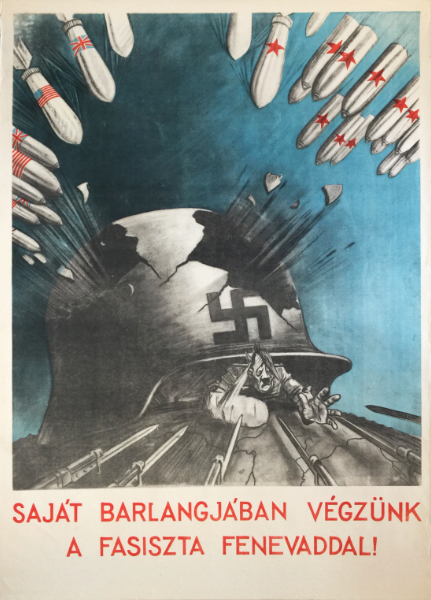
Sandor Ek - We will finish the fascist beast in its own cave 1945 Soviet Red Army Communist WWII war propaganda poster
The Hungarian Communist Party was created based on the soviet pattern, but they were unable to get into total power until 1949. Kisgazdapárt won the first election in 1945. A short democratic period began, which brought the revival of political poster art. The unity of Kisgazdapárt soon deteriorated due to the political maneuvers of the communists. As a result, in 1947, a new election took place. All democratic parties participated and advertised themselves with every type of propaganda acts, but most of all with posters. The results of the election were falsified in favor of the Communist Party. In 1948 the Social Democratic Party fusioned with the Hungarian Communist Party, which was a result of the “salami tactics” (they gradually “sliced up” their opponents) of the communists. Finally, the anti-democratic turn took place in 1949, when all parties were forced to merge with the Hungarian Workers’ Party, and the people were only allowed to vote for one list.
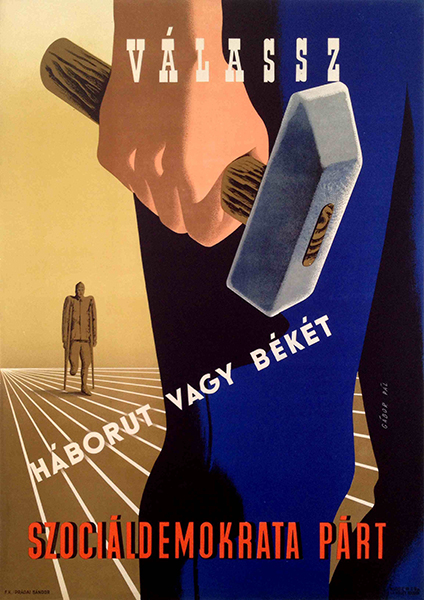
Pal Gabor - Choose betwwen war and peace - Social Democratic Party 1947 Hungarian propaganda poster
During the short period between 1945 and 1949 poster art and other forms of art flourished: the Európai Iskola (European School, a group of painters) was founded this time. The name of the group had a symbolic meaning: they put an emphasis on showing to the audience that they keep up with the international tendencies. In 1945, as a result of the leftist turn in politics, all the great artists of the former period returned to the field of political poster. In the earlier years most of them were occupied with cultural or commercial posters. Due to their political conscience, the best modern artists were never able to design propaganda posters during the Horthy-era. Thanks to their return, and the rise of new, talented artists, the political posters of this period represent a much higher artistic quality than that of the previous decades.
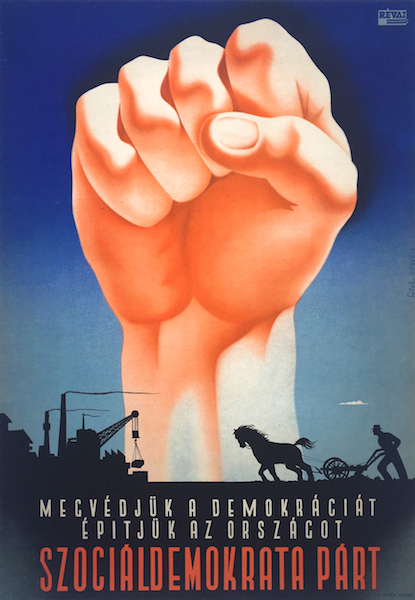
Gyozo Szilas - Laszlo Horvath - We protect democracy, we build the country - Social Democratic Party 1947 vintage Hungarian leftist political propaganda poster
Among the returning artists we find Sándor Bortnyik and his students from his art school, the “Műhely”, hence the modernist style of Bortnyik and Berény made its impact on the new propaganda posters. This attitude was dominant among the younger designers as well. Not only the artists who designed the posters were different, other significant changes also took place; first of all, the audience was not the same anymore. More people had the right to vote, that means that the target audience for political propaganda posters significantly grew. The posters addressed the whole society; they tried to communicate with each and every social class thus the posters had to be easy to understand, clear and simple. The messages were focusing on the workers and peasants; they dealt with their issues. The posters were powerful and convincing, this function was of utmost importance. The designers used well-known, famous symbols and the most easily understandable visual signs in a new context. A lot of them contain classic leftist symbols, such as red star, red flag, sickle, hammer, anvil, the typical figures of the workers, peasants and intellectuals.
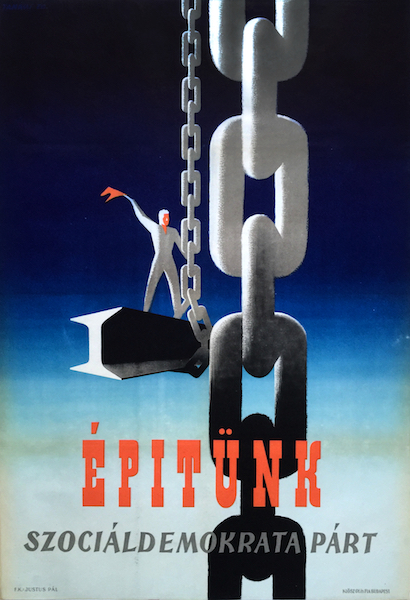
Zoltan Tamassi - We Build - Social Democratic Party 1947 vintage 1947 Hungarian election propaganda poster
Besides quality, the quantity of different propaganda posters was growing as well. There was an increasing demand for political communication, since the new regime wanted to channel its messages. The rebuilding and reorganization of the country was a central subject, new cultural habits, new icons, new cult figures and new holidays were introduced. Posters were made for the 3 and 5 year production plans, for urgent issues, like the newly formed cooperatives and the intensive industrialization. In addition the new regime used the propaganda for not letting the people forget aout the horrors of war and fascism. This was the the first step of embodying the enemy (that is, the bourgeoisie, the fascists and Nazis, and the counter-revolutionists and spies).

Mihaly Biro - The Social Democratic Party Builds the New State of the Workers! 1947 Hungarian election poster
György Konecsni became a central figure during this period: he was active as a teacher, a graphic designer and an artist. He was famous for his elegant, classicist, art deco designs of the 1930’s. From 1945, he developed a uniquely impressive visual language for propaganda: he used very powerful, compact symbols and motifs with short and effective slogans. His compositions became emblematic; they defined the way poster artists thought about propaganda poster design.
In 1945, one could sense a boom of propaganda posters. The artists were following their personal political preference, but it was not uncommon, that a designer worked for multiple political parties. Sándor Bortnyik designed the emblem of the Hungarian Communist Party; it unifies a red star and a flag. Konecsni was also working for the communists: one of his greatest designs is the “Bread starts here” poster, with the cleverly combined hammer and sickle. Konecsni created a series of successful posters in these few years; maybe because the messages matched to his personal convictions.
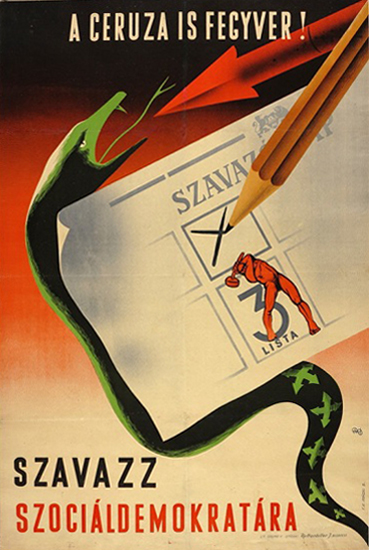
The Pencil is a Weapon! Vote for the Social Democrats! 1947 Hungarian propaganda poster
In 1945, because of the universal suffrage, the political posters had to address the complete Hungarian society. The most important factor was that these pieces had to be easily interpretable, that’s why the posters of Konecsni employed symbols known by everyone (sickle, hammer, plow, wheel, bread etc.), but these were paraphrased in a new context (the two most famous examples: And Yet There Will be Bread, Bread Starts Here). These works are visually inspired by the metaphysical painting: the endless distance and the antique elements express the eternal value of the message. Pathos is an essential component, but he never overuses it, he always adapts to the meaning.
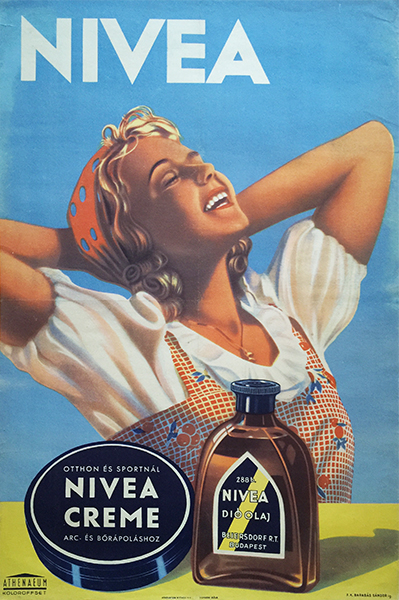
Nivea cream and walnut oil 1949 Hungarian poster
Zoltán Tamássi’s poster for the communists emphasizes their achievements in bringing the prisoners of war home. Several great artists worked for the Social Democratic Party, such as Tamássi, László Káldor, Károly Rohonyi and Pál Gábor. On the Social Democrat posters, Biró’s red-hammer-wielding man returned for one last appearance: now it was also a symbol of continuity. On Bedő’s poster the same symbol is creatively reused; it strikes down the emblems of the extreme right (the swastika and the arrow cross). The Kisgazdapárt (Yeoman Party) represented the middle-right in politics; their campaigns used Christian and national symbols. Most of their posters are not very artistic, but some exceptions can be found. The propaganda poster by the artist named “Rónai” is worth mentioning "Lelki újjáépítésért küzd” (The Party is Fighting for Rebuilding Our Soul).
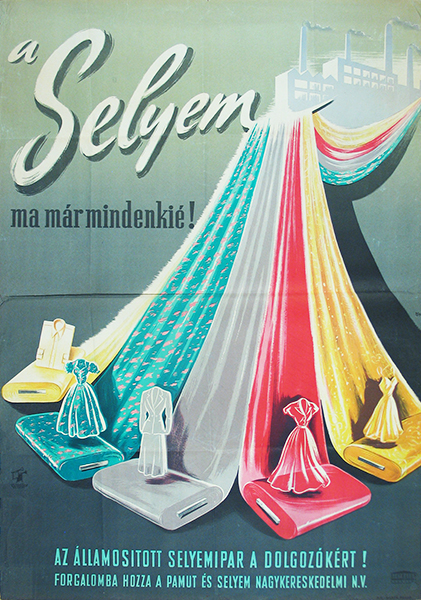
Janos Macskassy - Silk is now for everyone nationalized 1949 Hungarian poster
The Social Democrat election posters from 1947 are outstanding works. Pál Gábor represents the strength of the working class in one image on his “Choose between war and peace” poster. The compositions of László Káldor, Károly Rohonyi, Zoltán Tamássi (“Építünk” – We build), Győző Szilas and László Horváth are also powerful. Filo (Ernőné Mihályfi) uses photomontage, and creates an effective composition by repetition of the image. Mátyás Gál also created impressive political designs, following Konecsni's metaphisical style. His poster for the London Olypics of 1948 is also a beautiful composition.
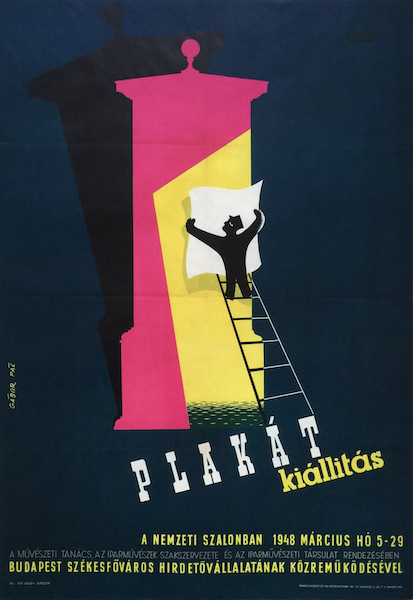
Pal Gabor - Poster Exhibition at the National Salon 1948 vintage Hungarian event poster
A poster exhibition in Budapest in 1948, proved the power of the new poster design principles. The artists themselves organized the exhibition, where they presented mostly original designs. Their works were reflecting to social issues, such as the efforts of rebuilding, the wish for peace and social solidarity. Multiple posters were designed and printed to promote the exhibition (by Pál Gábor, Károly Reich, Tibor Zala and Károly Rohonyi), they were all examples of the new, compact and powerful poster design.
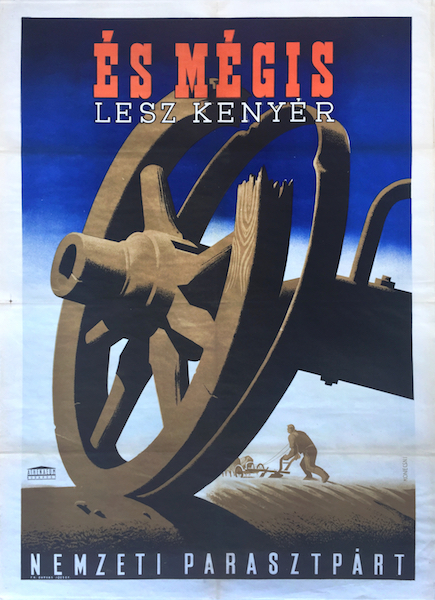
György Konecsni - And still there will be bread - National Peasants' Party 1945 vintage Hungarian political propaganda poster
The election in 1949 was advertised using socialist realist posters, and there was only one possible choice on the ballot. This election ended an outstanding period of Hungarian poster art. During these few years, many exceptional and influential posters were made. This development was halted by force until 1956.
Take a look at our inventory from this period by: clicking here.